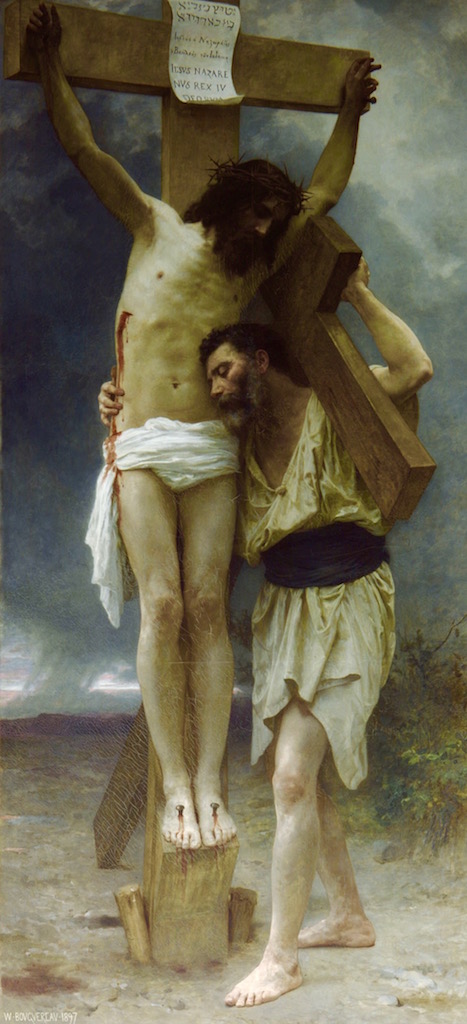In the painting Compassion by William-Adolphe Bouguereau (1825-1905), the echoes of compassion draw us in. The word “compassion” is derived from two Latin words cum (meaning “with” or “together”) and passion (meaning “suffering”). Take some time to pray with this painting. Who is suffering with whom? Who is comforting whom?
The crucified Christ is turned toward his disciple, who chooses both to carry his own cross and to turn toward Jesus in his pain. Though the disciple’s left hand holds his burden, his right arm encircles Jesus and the cross, with his right hand immersed in Christ’s flowing blood. The Savior is completely restrained, rendered helpless by the nails, yet he is still the Comforter and Source of his disciple’s strength. Despite the brutal pain portrayed here, a surprising sense of peace and timelessness permeates the scene.
A similar theme is found in lyrics from the song “How Love Wins (THIEF)” from Music Inspired by the Story: “This is how Love wins / Every single time / Climbing high upon a tree / Where someone else should die / This is how Love heals / The deepest part of you / Letting Himself bleed into / The middle of your wounds / This is what Love says / Standing at the door / You don’t have to be / Who you’ve been before.”
Consider the following questions:
1) What cross are you carrying for the sake of Christ? What cross is Jesus asking you to carry but you have not yet picked up? What do you need from Jesus in order to continue to trust God and persevere in carrying the cross you have or one he is inviting you to pick up? Ask God (Jesus, Father, Spirit) for what you need.
The crosses of Christ and his followers are not the same as suffering that comes from sin (our own or others’) or from the persistent brokenness of this world. For example, the suffering of abuse or of addiction is not necessarily a “cross,” though Jesus can still enter into this pain to accompany and comfort us. Instead, carrying a cross is voluntary. Like Jesus, we as disciples choose to carry our crosses, which directly result from submitting to the will of the Father for His sake, for our sake, and for the sake of others.
Jesus said, “Whoever wishes to come after me must deny himself, take up his cross, and follow me. For whoever wishes to save his life will lose it, but whoever loses his life for my sake and that of the gospel will save it.” (Mark 8:34-35) To his hearers, a “cross” symbolized not just suffering but death. Jesus was saying that for his sake and our own, our self-will, self-centeredness, and self-righteousness must die.
Yet the good news of Jesus is two-fold. First, we know the final victory will be His. Every hour and day we persevere brings us closer to seeing Christ unveiled, when the fullness and warmth of His intense, radiant love will fully heal and restore us and all of Creation. Second, Jesus wants to help us NOW. He chose to join us NOW in this broken world. Love wins NOW. Christ’s compassion, His suffering with us, can revamp our pain from producing pure destruction to bringing new birth, transformation, the fruit of the Spirit, and hope.
2) In what other ways are you suffering right now? Physical pain, disability or loss? Emotional pain—unmet expectations, fear, anxiety, confusion, despair, depression, discouragement, grief, or regret? Spiritual pain—doubt of God’s reality, power, knowledge or personal love for you, a sense of God’s absence or silence? What do you need to welcome Jesus into that suffering? He is “God with us.” What is God wanting to heal or relieve now? Ask God for what you need.
3) In what ways is God inviting you to show compassion to others? In what ways is God inviting you to receive compassion from others, from yourself, from God? Respond directly to God with these answers.
Consider listening to “Praying Through Your Pain” sermon by Jimmy Davis. This is an excellent message on Psalm 43, suffering, and prayer (in particular, the PAPA prayer).

